Finding and hiring top talent is more challenging than ever in today’s competitive job market. With an average of 250 resumes submitted per corporate job listing, recruiters are overwhelmed with applicants to screen through manually. This results in a 65% longer time-to-hire and risks missing out on great candidates who slip through the cracks.
To tackle this problem, more companies are turning to applicant tracking systems (ATS) to optimize and accelerate candidate identification. ATS software automates much of the screening process through features like customized keyword searches, configurable ranking algorithms, and data-driven insights. This enables recruiters to laser focus on the most promising applicants without wasting time on unqualified ones.
In this article, we’ll explore how you can quickly identify top candidates using ATS software. You’ll learn best practices for setting up automated workflows, analyzing data, and continually refining your criteria to align with top-performer profiles. Follow along for actionable tips on transforming your recruiting process using ATS to consistently identify and engage top talent faster.
Table of Contents
What is ATS Software and How Does it Work?
An applicant tracking system (ATS) is a recruitment software that helps automate and streamline the hiring process. Key features include:
- Candidate Database – Centralized repository for all applicant profiles and documentation.
- Resume Parsing – Extracts key candidate information like skills, experience, and education.
- Workflow Automation – Structures hiring steps like screening, assessments, and interviews.
- Customizable Ranking – Scores and ranks candidates based on configurable criteria.
- Analytics – Provides insights on metrics like time-to-hire and source of candidates.
- Integration – Connects with a background check, assessment, and HR platforms.
By handling administrative tasks like resume collection and basic screening, ATS allows recruiters to focus their time more strategically. The goal is to accelerate hiring efficiency and effectiveness.
The Traditional Screening Problem
Sifting through resumes and applications is one of the most time-intensive parts of recruiting. Yet, manual screening suffers from several key flaws:
- Volume Challenge: With an average of 250 applicants per corporate role, reviewing each submission comprehensively is impractical. This forces recruiters to sacrifice speed.
- Time Drain: Studies show recruiters spend over 60% of their time just on screening and pre-qualification. This leaves less time for strategic talent sourcing.
- Bias Risk: Humans unconsciously favour candidates with shared experiences, backgrounds, or demographics. This can lead to overlooking qualified applicants.
- Inconsistency: Manual screening often lacks structured criteria, leading to subjective or arbitrary decision-making.
- Lack of Insights: Without analyzing data on past candidates, it’s hard to refine criteria based on patterns with top performers.
These points directly undermine the efficient identification of your best-fit candidates. Too often, great applicants get overlooked while time is wasted on obviously unqualified submissions.
A better approach is needed to streamline screening, reduce bias, and strategically surface ideal candidates from your applicant pool. Next-generation ATS solutions provide the answer.
Let’s explore how modern applicant tracking systems can help resolve these screening challenges to rapidly identify top applicants worth pursuing. The key advantages are process automation, customizable criteria, and data-driven insights.
The ATS Solution
Modern applicant tracking systems offer several capabilities that directly address the flaws of manual screening:
- Automated Filtering: ATS allows setting up customizable filters based on keywords, experience, education, skills, and more. This automatically surfaces the most relevant candidates for review.
- Configurable Ranking: Smart algorithms can be configured to automatically score and rank candidates based on the importance of certain criteria. This highlights the most promising applicants.
- Unbiased Scoring: Structured, criteria-based ranking algorithms reduce unconscious bias that creeps in with human screening.
- Analytics-Driven Insights: ATS data reveals patterns linking specific credentials, experiences, and traits with top performers. This intelligence informs optimizing your criteria.
- Process Efficiency: By automating initial screening, ATS saves recruiters time and speeds up time-to-hire. More time can be spent on strategic sourcing.
- Continuous Optimization: The system fine-tunes itself over time as new hiring data reinforces what factors indicate an ideal candidate.
With ATS, your team can establish an efficient, unbiased, and insightful screening process optimized specifically for your roles. The system handles the heavy lifting so recruiters focus their expertise on assessing shortlisted applicants worthy of further consideration.
Now let’s walk through how to configure your ATS leveraging automation, customizable ranking, and data-driven analytics to rapidly identify top candidates.
The Benefits of ATS-Powered Screening
Leveraging your applicant tracking system’s capabilities can yield several recruiting and hiring benefits:
- Faster Time-to-Hire – By automating initial screening, ATS can shrink days or weeks from your hiring process. This enables you to connect with top talent faster before they get away.
- More Qualified Candidates – ATS makes it easier to zero in on applicants that closest match your ideal criteria for qualifications, skills, and experiences.
- Less Manual Screening – Recruiters spend less time digging through resumes and more time on strategic sourcing and engagement. This maximizes your human expertise.
- Reduced Biases – Structured filtering minimizes unconscious biases that can creep in during manual applicant reviews.
- Better Quality of Hire – Optimized screening means higher performing new hires once onboarded.
- Improved Candidate Experience – Automated status updates and scheduling through ATS create a more responsive experience.
- Informed Optimization – Analytics help continuously refine criteria and processes based on patterns with top performers.
The bottom line is that ATS-powered screening helps your recruiters work smarter, not harder. Prioritizing automation and data minimizes the manual grind while maximizing how you identify and attract ideal candidates.
What are the Challenges of Using ATS to Identify Top Candidates?
While applicant tracking systems provide many advantages, realizing their full potential for identifying top talent requires avoiding some common pitfalls. We’ll cover the major challenges and missteps to be aware of when implementing and configuring ATS technology. Understanding these potential downsides will help you maximize the value of your system:
- Improper Criteria – Not carefully considering what factors indicate an ideal candidate.
- Lacking Customization – Failure to tailor algorithms and workflows for specific roles.
- Over-automation – Removing human touch points too early in the process.
- Data Deficits – Not utilizing reporting and analytics enough for optimization.
- Integration Gaps – Important systems like assessments are not interconnected.
To maximize ATS for identifying top candidates, invest time configuring criteria and workflows. Strike the right balance between automation and human judgment. Use data and analytics to continually refine screening.
Example ATS Workflow for Screening Candidates
Let’s walk through an example of how to set up an effective ATS screening workflow for a software engineering role:
1. Define Core Criteria
First, determine the must-have qualifications, skills, and experience levels for candidates to be considered a potential match. For software engineering, this may include:
- Education like a CS degree or bootcamp
- Years of experience
- Specific languages and frameworks
- Software specialities like front-end, back-end, and full-stack
2. Configure Keyword Search
Enable resume keyword search for terms that indicate core criteria. Applicants with enough mentions will automatically surface for review.
3. Set Up Custom Ranking
Build a custom algorithm that assigns points for key qualifications and skills. This will automatically rank candidates based on your priorities.
4. Integrate Assessments
Incorporate online technical assessments into the ATS workflow to evaluate hands-on skills. Scores can further refine ranking.
5. Review Top Matches
The recruiter now spends time assessing the top-ranked candidates from the automated screening process. This is where human judgment comes into play.
6. Optimize Criteria
Use ATS analytics to identify patterns among top performers and refine criteria to better target high-potential candidates.
Following a structured ATS process makes identifying qualified applicants scalable. The system handles the tedious parts so recruiters focus on more strategic evaluation.
How to Choose the Best ATS Software for Your Needs
Not all applicant tracking systems are created equal. The right ATS solution for your organization depends on several key factors. We’ll outline what to look for when evaluating different software options. Key factors when selecting an ATS include:
- Role-specific customization – Can workflows and ranking be tailored to unique hiring needs?
- AI capabilities – Is smart resume parsing, chatbot engagement, etc included?
- Data and integration – Does the system extract insights and connect with other platforms?
- Candidate experience – Is the portal and communication process user-friendly?
- Implementation and support – How much training and assistance is involved?
The best ATS aligns tightly with your current processes while optimizing candidate identification. Ensure any system you choose is configurable, intuitive, and insight-driven.
Conclusion: Transform Your Candidate Screening with ATS
Manual resume screening is inefficient, inconsistent, and prone to bias. Attempting to identify top applicants this way wastes precious recruiter time and risks losing out on great candidates.
Applicant tracking systems provide a better approach through customizable workflows, unbiased scoring, and data-driven insights uniquely suited for optimizing candidate identification.
By following the best practices outlined in this article, you can configure your ATS to handle the initial heavy lifting and surface the most promising candidates for you to evaluate. The key is striking the right balance between automation and human judgment. Let software power through volumes of applicants, but leverage recruiters’ expertise in assessing shortlisted talent.
As your hiring needs change or new performance data emerges, continue refining your ATS criteria and workflows. Use the system’s insights to work smarter, not harder finding top talent. With the right process in place, your team can rapidly pinpoint ideal candidates that move your organization forward.
Article you might be intrested in: Transform Your Hiring with an Efficient & Effective Process







0 Comments